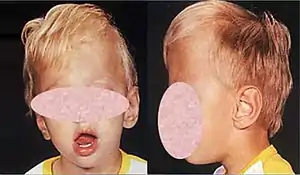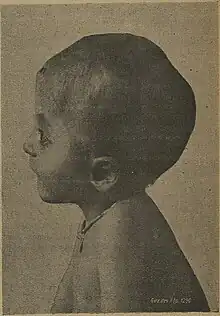Turricephaly
Turricephaly is a type of cephalic disorder where the head appears tall with a small length and width.[3][4] It is due to premature closure of the coronal suture plus any other suture, like the lambdoid,[5] or it may be used to describe the premature fusion of all sutures.[2] It should be differentiated from Crouzon syndrome. Oxycephaly (or acrocephaly) is a form of turricephaly where the head is cone-shaped, and is the most severe of the craniosynostoses.[4]
| Turricephaly | |
|---|---|
| Other names | Oxycephaly,[1] Acrocephaly, Hypsicephaly,[1] Oxycephalia,[1] Steeple head,[1] Tower head,[1] Tower skull, High-head syndrome, Turmschädel[2] |
 | |
| Specialty | Dysmorphology |
| Symptoms | reduced head length and width for age |
Presentation
Common associations
It may be associated with:[6]
Conditions with turricephaly
Conditions with turricephaly include:[7][8]
- Achondrogenesis, type IA
- Acrocephalopolydactyly
- Acrocephalosyndactyly type V (Goodman syndrome)
- Acrocraniofacial dysostosis
- Alopecia - contractures - dwarfism - intellectual disability syndrome
- CEBALID syndrome
- Chromosome 1q21.1 deletion syndrome
- Chromosome 4Q32.1-q32.2 triplication syndrome
- Chromosome 5p13 duplication syndrome
- Cole-Carpenter syndrome 2
- Craniorhiny
- Craniosynostosis (nonsyndromic) 6
- Craniosynostosis, Boston-type (nonsyndromic)
- Craniosynostosis and dental anomalies
- Fontaine progeroid syndrome
- Gomez Lopez Hernandez syndrome
- Intellectual developmental disorder, autosomal dominant 65
- MEGF8-related Carpenter syndrome
- Mosaic trisomy 12[9]
- Myopathy, epilepsy, and progressive cerebral atrophy
- Peroxisome biogenesis disorder 2A (Zellweger)
- Potocki-Shaffer syndrome
- Saethre-Chotzen syndrome
- Spondyloenchondrodysplasia with immune dysregulation
- Spondylometaphyseal dysplasia, Sedaghatian type
- Summitt syndrome
- Teebi-Shaltout syndrome
- Tolchin-Le Caignec syndrome
- TWIST1-related craniosynostosis
- Usmani-Riazuddin syndrome, autosomal dominant
 Carpenter syndrome
Carpenter syndrome.jpg.webp)

.jpg.webp)

 Saethre-Chotzen syndrome
Saethre-Chotzen syndrome
Diagnosis
See also
References
- Mosby's Medical Dictionary (8th ed.). Elsevier. 2009. Retrieved 24 August 2013.
- Bodian, Martin (May 6, 1950). "Oxycephaly". Journal of the American Medical Association. 143 (1): 15–8. doi:10.1001/jama.1950.02910360017006. PMID 15415226.
- "Turricephaly". Elements of Morphology. National Human Genome Research Institute. Retrieved 2022-10-29.
- Allanson, Judith E.; Cunniff, Christopher; Hoyme, H. Eugene; McGaughran, Julie; Muenke, Max; Neri, Giovanni (January 2009). "Elements of morphology: standard terminology for the head and face". American Journal of Medical Genetics. Part A. 149A (1): 6–28. doi:10.1002/ajmg.a.32612. ISSN 1552-4833. PMC 2778021. PMID 19125436.
- "oxycephaly". TheFreeDictionary. Retrieved 24 August 2013.
- Weerakkody, Yuranga; Goel, Ayush. "Oxycephaly". Radiopaedia.org. Retrieved 24 August 2013.
- "Turricephaly (Concept Id: C5399823)". www.ncbi.nlm.nih.gov. Retrieved 2023-09-14.
- "Oxycephaly (Concept Id: C4551646)". www.ncbi.nlm.nih.gov. Retrieved 2023-09-14.
- "Mosaic trisomy 12 (Concept Id: CN073989)". www.ncbi.nlm.nih.gov. Retrieved 2023-09-14.
Further reading
- NINDS Overview
- Ebenezer, Roy (1960). "Craniostenosis or oxycephaly". Indian Journal of Ophthalmology. 8 (3): 77–80. ISSN 0301-4738. PMID 13819157.
This article is issued from Wikipedia. The text is licensed under Creative Commons - Attribution - Sharealike. Additional terms may apply for the media files.